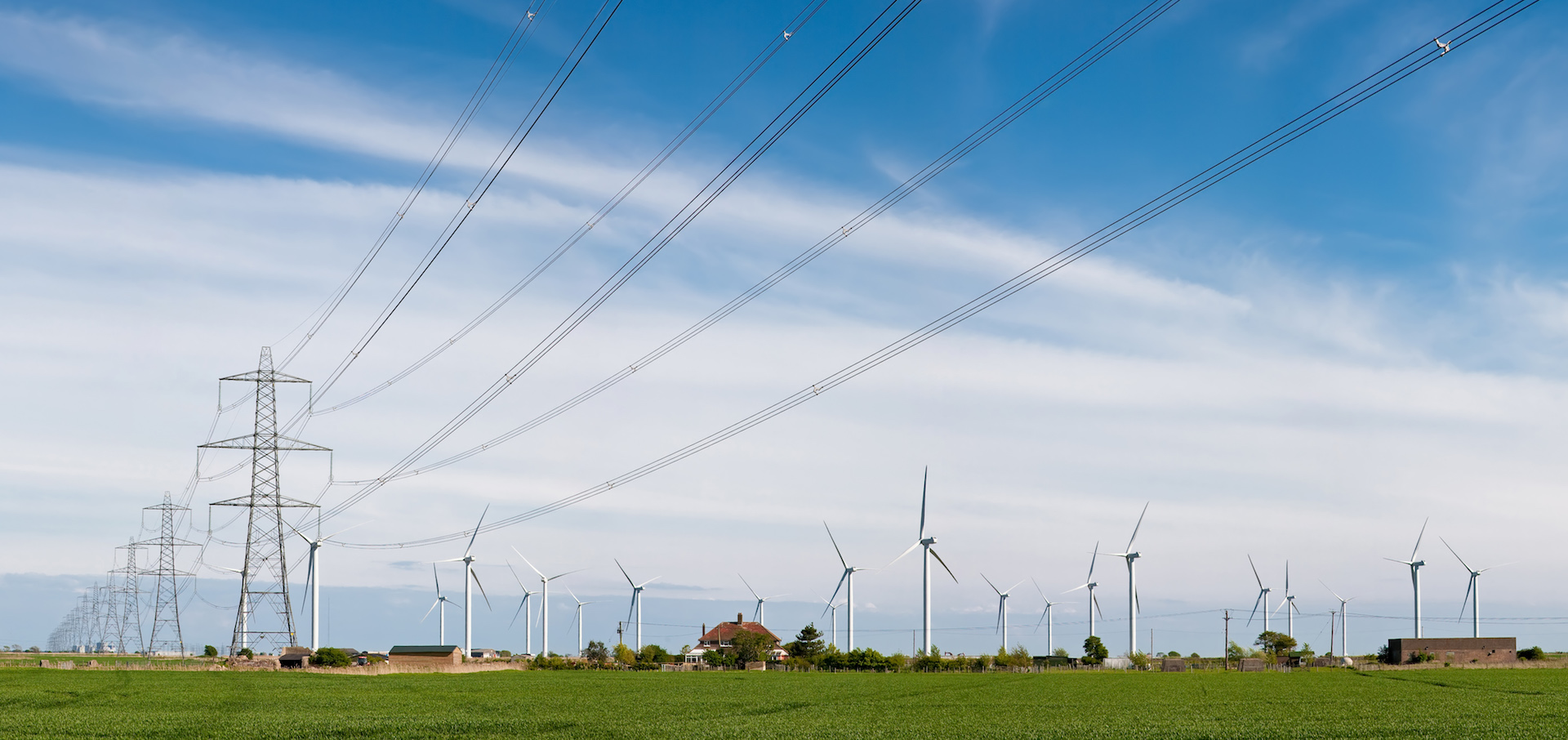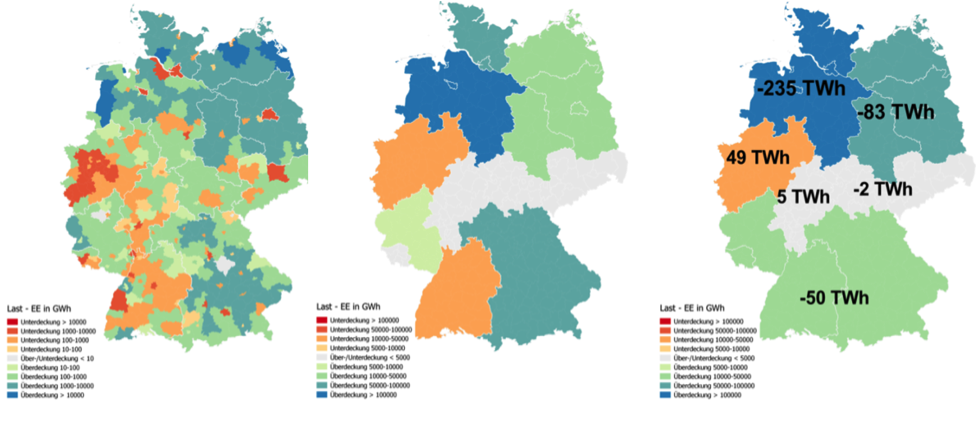Researchers at Germany’s Öko-Institut have published a review of nearly a dozen previous studies on the need for new power lines in a future renewable electricity supply. The main finding is that the research community isn’t yet speaking the same language. Craig Morris explains.

How can Germany deal with its overloaded power lines? (Photo by David Iliff, CC-BY-SA 3.0)
If Germany spread wind turbines and solar arrays more evenly across the country, fewer power lines would need to be added – this statement is widely accepted. But a new “meta-study” published by Öko-Institut tries to put a finer point on the matter. Its title (in German, but with an English summary) reveals the main finding: “Even a distributed energy transition needs grid expansion.”
Two competing worldviews (which the study called “narratives”) are in play here: centralized versus distributed. Electricity is cheaper when we build wind farms where it’s windy and solar arrays where it’s sunny, but this centralized approach entails additional costs when these sites need to be connected to cities via new power lines. In Germany, most studies indicate that the centralized approach remains cheaper in the end. But a country can decide to pay more for certain qualities; for instance, Germany’s energy transition began specifically as a grassroots effort to decentralize energy supply for political reasons. Ownership mattered for those people.
The problem is that “distributed” isn’t clearly defined. A solar roof on a private home is the textbook definition of distributed; the household can consume a lot of its own solar power directly, aka “behind the meter”; solar power consumed on site doesn’t touch public power lines. Giant offshore wind farms with dozens of turbines a hundred kilometers from the nearest city are the textbook example of centralized. But what about a ground-mounted array 100 times bigger and 500 meters from the next grid connection point? Where do you draw the line between distributed and centralized?
One could say distributed is where no new power lines need to be built. But Germany already has overloaded power lines. The problem is: Grid congestion occurs locally, but Germany only has price signals for the entire country. One proposal is to break the grid into sub-grids or “nodes,” each with its own prices. But the EU is pushing for greater power trading across the continent.
The meta-study therefore says nodal prices are unlikely to materialize: “nodal pricing… (which has not really been specified yet and remains quite vague) would very fundamentally change the current market and regulation model in the EU, which is hardly likely for the next decade at least.” This topic warrants its own blog post; there’s lots of talk within Germany and the EU about regional flexibility. One wonders whether the authors think existing EU policy cannot be made to accommodate nodal pricing or whether it simply cannot be done within the next 10 years.
How big should the nodes be? The maps below simplify the numerous options used in the literature. The colors represent, from red to blue, the share of power consumption that could be met with local renewables within a given area under realistic assumptions. On the left, we see Germany’s 402 counties (Landkreise); in the middle, its 16 states (Bundesländer); and on the right, six grid zones proposed for an investigation of distributed renewables (Germany has four transmission grid zones run by different companies, which don’t overlap with these six).

Graphic via Öko-Institut
On the left, densely populated areas (in red) like Hamburg, Berlin, the Ruhr Area, and Munich would all have the hardest time meeting their own demand with renewables. But expand those zones to the 16 states, and the red disappears, with only two areas remaining yellow. At six zones, only one area is yellow.
The meta-study thus finds that larger (more centralized) zones are easier to manage; the smaller (and more distributed) the zones, “the greater the cost of power generation and flexibility options.” Why have nodal prices at all then – just centralize? Take the argument to its logical conclusion: instead of building solar in southern Germany and wind along the northern coasts, why not skip solar altogether in Germany and build it all in Spain, Italy, and Greece, connecting everything with power lines? We could even store really cheap wind and solar power from northern Africa as hydropower in Scandinavia. That was even the plan a decade ago.
We’re not doing this despite the apparent lower cost on paper because it’s unrealistic. The French are unlikely to fill up their landscapes with power lines so the Germans can get cheaper electricity. Likewise, a country might place great store on resilience: the ability to create your own reliable energy supply instead of being dependent on imports. (Distributed renewables are now sold as part of a resilience toolkit in areas of the US hit by extreme weather events.) And what applies across national borders can also apply within a single country. A low price isn’t everything; people are willing to pay more for certain qualities.
How much more would need to be paid is unclear because, the meta-study finds, there are no agreed metrics for scenarios. In addition to the two obvious parameters that scenarios set (how much distributed renewable energy can be consumed “behind the meter” and how much wind & solar need to be built where), the meta-study identifies two other crucial gaps for future investigations:
- we need a standardized way of assessing total cost and land consumption, and
- we need a metric with which to derive the need for grid expansion across different models.
Only then can we have a discussion about narratives: for instance, what extra amount a given level of resilience will cost. By highlighting these gaps, the meta-study is a true step forward in the discussion.
There were 400MW of PV added in Germany in the first two month – this looks like a new boom:
https://www.pv-magazine.com/2018/04/03/germany-adds-another-200-mw-of-solar-in-february/
The separation of the Austrian and German power market allows Austria thanks to the now higher power prices to become electricity independent. which blows apart all past grid extension dreams, Austria could supply Bavaria and BW in a couple of years with REs:
https://www.pv-magazine.de/2018/04/03/oesterreich-plant-100-000-daecher-programm-fuer-photovoltaik-und-heimspeicher/
Italy just reduced the electricity prices by a massive 8% taking another client from the international power market, certainly from the Nort-to-South market:
https://www.platts.com/latest-news/electric-power/barcelona/italys-power-tariffs-drop-8-in-q2-gas-tariffs-26928052
The new power lines are meant to help the atomic incumbents like Belgium and France, the EU insists on more transport capacities from Denmark to Germany. And this power is better paid in Belgium and France, Nl and UK.
https://www.bundesnetzagentur.de/SharedDocs/Pressemitteilungen/DE/2018/20180329_anord.html
Spain is doing it’s best from the other side:
https://www.pv-magazine.com/2018/04/03/spain-government-expects-solar-to-dominate-by-2030-with-up-to-77-gw/
Vienna’s community utility plans 600MW PV for 2030:
https://www.pv-magazine.com/2018/03/23/austrian-utility-wien-energie-begins-solar-offensive/
So there is little use for the Nort-South interconnectors as far as I see, except for 8% or 9% guaranteed profit/ROI per year to the grid owner.
These maps remind me of the Holy Roman Empire – I hope that that does not become a model for the energy future of Germany. Seriously, the future will have to be a mix of distributed and concentrated generation resources, and some professional modelling must be devoted to this. The ISE Fraunhofer model assumed, if I recall correctly, a ‘copper plate’ model for Germany, with current-limited interconnections to the neighboring states. It would be possible to model Germany as a group of copper plates with interconnectors and to see how the costs and local energy structure change.
I assume that the fundamental component of the resilience toolkit is a diesel generator.